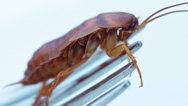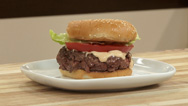Cook's Illustrated: Sugar
- Posted 10.25.12
- NOVA scienceNOW
We all know that adding sugar to food makes it sweet. But the type of sugar you use doesn't just influence flavor—it also changes texture. Learn which sugar to use for the perfect chewy or crunchy cookie.
Transcript
Cook's Illustrated: Sugar
Posted: October 25, 2012
Cook's Illustrated
The Science of Good Cooking
Concept 48: Sugar Changes Texture (and Sweetness)
Dan Souza (Associate Editor, Cook's Illustrated): We all know that if you add sugar to a dessert it makes it sweeter. But did you also know that it can have a huge impact on texture? Sugar can drastically change the structure of baked goods, such as cookies. How does it do it? Well, it has everything to do with moisture. Sugar is naturally hygroscopic, meaning it has an affinity for water molecules. Now, because of this tendency, sugar can slow the evaporation of moisture from cookies and cakes as they bake, which can have a tremendous impact on the final texture.
Now, all sugar is not the same. You have white sugar, brown sugar, honey, molasses, and many more, and each has a slightly different structure. Now, sugar can be a single molecule made up of hydrogen, oxygen, and carbon. Examples of such simple sugars are glucose and fructose. Or, like sucrose, which is white table sugar, it can be composed of multiple molecules—in this case, one glucose and one fructose—tied together with chemical bonds. Now, when you heat sucrose with an acid, it breaks down into the these two smaller sugars, resulting in something we call invert sugar. This small chemical change makes a big difference: while sucrose is hygroscopic, invert sugar is even more water attracting. Want proof?
First off, brown sugar contains more invert sugar than does white sugar. So, we stored a slice of white bread in a sealed container with a 1/4 cup white sugar and one in a sealed container with a 1/4 cup brown sugar for about a day and a half. While both sugars absorbed moisture from the bread, the brown sugar was far more effective due to its higher amount of invert sugar. As you can see, the brown sugar absorbed so much moisture from this slice of bread that I can snap it like a piece of toast. On the other hand, the slice stored in white sugar is still moist enough to bend and flex.
This is all well and good, but who really cares about dried out slices of white bread? Let's apply this information to use on something we do care about: cookies.
So, we made two batches of oatmeal cookies, one with brown sugar and one with white sugar. Now, to isolate this variable, we kept all other ingredients and the baking procedure identical. We repeated this test three times.
After the cookies had cooled to room temperature, we tasted them for chewiness and then attempted to bend them around a rolling pin like this. The results are clear as day. The oatmeal cookies made with brown sugar have serious chew and the flexibility to easily conform to the curvature of the rolling pin. On the other hand, the cookies made with white sugar are crunchy rather than chewy, and quickly snap when bent.
So, the next time you're looking for a good crunchy, or chewy, cookie, look to sugar. It does a whole lot more than add sweetness.
Credits
Production Credits
- Video short produced, photographed, and edited by
- Nick Dakoulas
- Test Kitchen Experiment Editor
- Dan Souza
- Project Editor
- Molly Birnbaum
- Science Editor
- Guy Crosby, Ph.D.
- Editorial Director
- Jack Bishop
- Original Footage and Illustrations
- © America's Test Kitchen 2012
Image
- (cookies)
- © America's Test Kitchen 2012
Related Links
-

Can I Eat That?
Learn about the neuroscience of taste, why we cook our food, what makes a Thanksgiving turkey savory, and more.
-

Cook's Illustrated: Burgers
Learn how to make tender burgers at home, the scientific way.
-

Food Science: Expert Q&A
Michael Brenner, who teaches a class on the science of cooking, talks about egg whites, ethylene, protein, and more.



